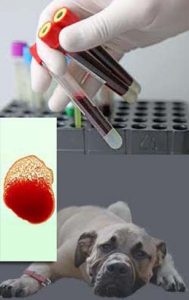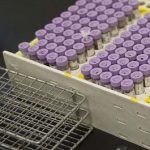Ron Hines DVM PhD
 Causes Of Most Abnormal Blood & Urine Tests
Causes Of Most Abnormal Blood & Urine Tests
autoagglutination Positive Blood Samples
 The links to the ANA Test and the Coombs Test that you also see above detect similar immune system problems in your pet
The links to the ANA Test and the Coombs Test that you also see above detect similar immune system problems in your pet
When your dog or cat produces defensive antibodies against its own red blood cells, your pet has developed a form of autoimmune disease. One characteristic of these autoantibodies against one’s own tissue is that they often cause the pet’s red blood cells in a test tube or drop of its blood to form beads and clumps (as they did on the slide in the photos above). autoagglutination can be a transient problem resulting from an infectious disease (read here), due to a curable tick or flea-born infection (read here), or even a recent vaccination (read here) autoagglutination and the anemia it often causes can be a temporary phenomena, or it can be permanent. Transient or permanent, it often causes an autoimmune hemolytic anemia. That anemia, rapid respiration, panting, weakness and pale gums are the most common reasons these pets are brought to veterinarians like myself. The numerous events with the potential to cause this problem to suddenly appear are called “triggers”.
The genetics of your pet can play a part in this problem too. Old English sheepdogs, Irish setters, cocker spaniels and poodles seem a bit more susceptible. But any breed can develop autoagglutination.
Auto-agglutination It is seen more frequently in dogs than in cats. But when cats are affected, the most common cause is infections with babesia felis, hemotropic mycoplasma (aka feline infectious anemia, hemobartonellosis) or bartonellosis. (read here & here)
This test is sometimes performed by swirling a drop of the pet’s blood on a glass microscope slide. However, just as commonly, it is observed accidentally as blood is being processed by your veterinarian’s nurse/technician for analysis. RBC agglutination has also been used as a crude test to see if the blood of a donor cat is compatibility with the recipient cat before a cross-transfusion is considered. autoagglutination is temperature sensitive. So in some cases the agglutination reaction is greater at low temperatures and sometimes at higher ones.
The treatment of autoimmune anemia in dogs and cats relies on drugs like prednisone and prednisolone or cyclosporine that decrease antibody production indiscriminately. Removing the pet’s spleen can also be helpful. People who develop immune hemolytic anemia have other options. The most common one is rituximab, a monoclonal antibody. However, mAb medications are species specific. If they were designed to work in a human, they do not work in dogs or cats, and vice versa. Zoetis has the technology to make one for a dog or cat. But the demand is not great enough for them to do so.
Complementary tests:
CBC and blood chemistry panel, RBC count, red blood cell morphology (= anisocytosis, poikilocytosis, RDW), reticulocyte count, blood globulin level, bilirubin level, Coombs test, ANA test, AG ratio
DxMe
You are on the Vetspace animal health website
Visiting the products that you see displayed on this website help pay the cost of keeping these articles on the Internet.



